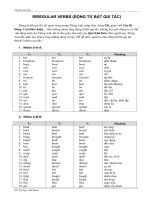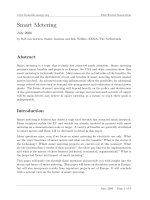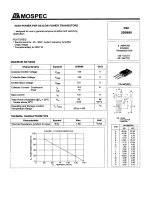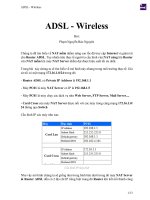TÀI LIỆU THAM KHẢO TIẾNG ANH CHUYÊN NGÀNH ĐIỆN TỬ VIỄN THÔNG
Bạn đang xem bản rút gọn của tài liệu. Xem và tải ngay bản đầy đủ của tài liệu tại đây (264.21 KB, 9 trang )
www.leonardo-energy.org
Distributed Generation
Smart Metering
July 2006
by Rob van Gerwen, Saskia Jaarsma and Rob Wilhite, KEMA, The Netherlands
Abstract
Smart metering is a topic that recently has attracted much attention. Smart metering
promises many benefits and projects in Europe, the USA and other countries show that
smart metering is technically feasible. Main issues are the actual value of the benefits, the
cost involved and the distribution of cost and benefits of smart metering between market
parties involved. An advanced metering infrastructure offers the possibility for additional
energy related services such as demand side management and realisation of virtual power
plants. The future of smart metering will depend heavily on the policy and decisiveness
of the governmental bodies involved. Energy savings and an increased security of supply
will be main drivers and believe in smart metering as a means to reach these goals is
indispensable.
Introduction
Smart metering is without any doubt a topic that recently has attracted much attention.
Many countries within the EU and outside are already involved in projects with smart
metering on a demonstration scale or larger. A variety of benefits are generally attributed
to smart meters and these will be discussed in detail in this paper.
Many questions arise, even if we focus on smart metering for electricity use only. What
are the exact functions of smart meters and what are the benefits? What is the status of
the technology? Which smart metering projects are carried out at this moment? What
are the (intermediate) results of these projects? Are there any barriers for implementation
and what is the nature of these barriers (technical, economical, organisational)? What is
the projected future and impact of smart metering?
This paper will guide you through these questions and provide you with insight into the
status and future of smart metering. This paper will focus on electricity meters in Europe,
but will also incorporate results from important projects out of Europe. It will conclude
with a general view on the future of smart metering.
June 2006 – Page 1 of 9
www.leonardo-energy.org
Distributed Generation
Smart meters, what do they do?
Smart metering generally involves the installation of an intelligent meter at residential
customers and the regular reading, processing and feed back of consumption data to the
customer. A ”smart” meter has the following capabilities:
• real-time or near-time registration of electricity use and possibly electricity generated locally e.g., in case of photovoltaic cells;
• offering the possibility to read the meter both locally and remotely (on demand);
• remote limitation of the throughput through the meter (in the extreme case cutting
of the electricity to the customer)
• interconnection to premise-based networks and devices (e.g., distributed generation)
• ability to read other, on-premise or nearby commodity meters (e.g., gas, water).
Usually, a smart meter is considered for registry of electricity and gas use, but also water
consumption registration is a possibility. In figure 1, an example of a typical smart meter
and its functions are schematically shown.
Electricity
Meter
Gas Meter
Home
appliances,
Display
Control
Measure
1234
5678
Logging
Processing
Control
1234
5678
Switch off
Modem
Electricity
Gas
Figure 1: Schematic overview of a typical smart meter configuration [1]
The ’intelligence’ of the meter is incorporated in the electricity meter. It has three basic
functions: measure the electricity used (or generated), remotely switch the customer
off and remotely control the maximum electricity consumption. The electricity meter
communicates by means of a modem. An important characteristic is the communication
infrastructure used by the smart meter for this communication. Amongst the possibilities
are Power Line Carrier (PLC, using the existing electricity grid); a wireless modem (GSM
June 2006 – Page 2 of 9
www.leonardo-energy.org
Distributed Generation
of GPRS) or an existing permanent internet connection (ADSL). An interface connects
the smart meter to home appliances or a home display. Appliances can be controlled
directly and the display can be used to show (historic) energy data and energy cost. In
this example a gas meter is coupled to the electricity meters and borrows the ”intelligence”
and communication facilities of the electricity meter.
Technologically, there are no obstacles for the introduction of smart metering. The Italian
case (roll out of approximately 30 million smart meters at residential customers) and
numerous demonstration projects in other countries show that the technology (smart
meter, infrastructure, data processing) is mature and can be implemented on a large
scale. A smart meter is a logical successor of the mechanical electricity meter, just as
the pick-up, the dial phone and the typewriter are replaced with digital, more intelligent
alternatives.
Smart Metering is often referred to as automated meter reading (AMR), or in the case of
real-time, two-way communications, as advanced metering infrastructure (AMI).
Benefits of smart meters and parties involved
Many advantages are attributed to smart metering, including lower metering cost, energy
savings for residential customers, more reliability of supply, variable pricing schemes to
attract new customers and easier detection of fraud. Additional benefits are foreseen
in relation to distributed generation (DG). The smart meter can be used to separately
measure electricity delivered by the DG to the grid and the smart metering communication
infrastructure can be used to remotely control DG (e.g., in a virtual power plant concept).
Smart meters offer benefits to multiple parties. Therefore, a distinction is made between
energy users, grid company, metering company, supplier and government. Not all countries make a distinction between grid and metering company, but as their tasks differ
this paper uses the distinction for clarity. Benefits can be explained by looking at the
differences between the current situation with the old meter and the future situation with
the new meter, as shown schematically in figure 2.
Demand response by domestic energy users is not yet a common practice, but would be
enabled by smart metering. Smart meters are capable of limiting or even cutting off the
energy use when triggered by market developments1 . When all households and small to
medium enterprises (SME’s) in a country would be able to adapt their energy use during
a period of high prices or diminished availability, this would improve the reliability of
supply en enhance energy market transactions, energy savings, energy awareness and
1
Limiting the electricity use may be accomplished by cutting off the electricity when the flow exceeds
a certain maximum value during a certain time and restore it when the flow is reduced.
June 2006 – Page 3 of 9
www.leonardo-energy.org
Distributed Generation
“dumb”meter
“Dumb”
Meter
Manual
Reading
Manual or
Automated
processing
“smart” meter
Home
communication
“Smart”
Meter
Interface,
Protocol
Database
Gateway
Interface,
Protocol
Database
Figure 2: Difference between the conventional and the smart meter data process [1]
energy efficiency. These long term advantages of smart meters may well contribute to
energy policy goals of governmental bodies.
On the shorter term, energy users benefit from the smart meter as they have a direct
review possibility of their energy use. By adjusting their behaviour, they can reduce their
energy cost. Also, they may receive a final bill on monthly basis instead of paying an
advance (although some customers prefer a fixed monthly payment anyway).
The metering company faces the challenge of initially replacing old meters by smart
meters. When smart meters are installed, this requires another type of operation for data
collection and data communication. As smart meters introduce a high amount of frequent
data flows, processes and systems must be adapted and prepared accordingly. The data
collection process will not depend on clients being at home but will be a continuous,
automated process, which should simplify daily operation of the metering company.
When all energy use is monitored by smart meters, grid companies will receive a much
more actual and accurate overview of energy consumption in their region. This means they
can examine suspicious areas where energy use is higher than expected, and thus smart
metering will provide grid operators with a tool to detect fraud. In times of electricity
shortage, the grid operator has the option to limit electricity use. Gathering all data,
the grid operator will be able to predict electricity flows more accurately and use this
knowledge in network and maintenance planning. The automation of the data collection
process, with more, recent data on a higher frequency, will put higher requirements on
systems. This will also have impact on market facilitating processes, as reconciliation of
formerly profiled users may become unnecessary.
To the supplier, the smart meter offers possibilities to offer new and dedicated services to
June 2006 – Page 4 of 9
www.leonardo-energy.org
Distributed Generation
their customers. The smart meter may become a gateway into the home of the customer,
to provide new value added services. Also for the billing process, real consumption data
can be used, simplifying the current process of advances and recalculation.
Figure 3 gives an example of automatic meter reading (AMR) benefits for a typical US
situation. Normal read savings refer to the reduction of direct and indirect meter reading
labour. The labour reduction refers to additional reduction in call centre labour, billing
and collection and disconnection of defaulters. Process improvements include reduced
energy theft, increased billing accuracy and tighter billing and collection. Infrastructure
improvements refer to the benefits of a more accurate, digital meter and the fact that
installing new meters in a whole area will reduce the future meter replacement budget.
Smart metering offers a potential yearly benefit of 11-39 EUR, according to figure 3.
Smart metering cost may vary but e80 for a smart meter and e 40 for installation are
reasonable estimates. So smart metering looks feasible but it depends on the financial
assessment made.
Benefits (EUR per meter read per month)
3,50
3,00
0,55
0,12
2,50
0,97
2,31
2,00
0,11
1,50
0,38
0,17
1,00
0,41
0,50
minimum
0,93
0,53
0,00
Normal Read
Labor Reduction
Process
Improvement
Infrastructure
Improvement
Revenue Cycle
Improvement
Figure 3: Example of AMR minimum and maximum benefits
June 2006 – Page 5 of 9
www.leonardo-energy.org
Distributed Generation
Current projects
This section contains an overview of smart meter projects in Italy, Sweden, the Netherlands, the United Kingdom, Victoria (Australia), Ontario (Canada), California (USA)
and Northern Ireland.
The Italian utility ENEL introduced smart meters already in 2001 in their ”Telegestore
project” [2, 3]. Before deregulation of the energy market ENEL (still as a state-owned
monopolist) made the in-company investment decision to introduce smart meters as first
utility worldwide. Important reasons for ENEL were the expected savings or revenues
in the areas purchasing and logistics, field operations, customer services and revenue
protection (fraud). The regulator or government or other market parties had no or only
marginal influence on requirements ENEL had to fulfil. Regarding the type of meter or
the communication infrastructure ENEL was left totally free. ENEL has chosen for a
smart electricity meter that communicates through PLC to the nearest substation. Next,
centralised control rooms read the data through GSM. By the end of 2005, ENEL had 27
million smart meters installed, of which 24 million meters are being remotely managed
and bimonthly read.
In Sweden the first studies into smart metering were carried out in 2001 [4]. Some companies had pilot projects then, but the government foresaw opportunities for energy savings
and wanted to exploit the potential benefits. By obliging the grid companies to a monthly
meter reading for all electricity users by 2009, the government stimulated the introduction
of smart metering. This bill was passed in 2003. Since, investments in smart metering
have developed in a faster rate than required by law.
In the Netherlands, the government is considering legislation to introduce smart metering
after having conducted a detailed cost-benefit analysis for nation wide introduction of
AMR [5]. The proposed legislation should become public by September 2006. Starting
in 2008, all residential customers will get a smart meter. Proposed time frame for this
introduction is 6 years. Minimum requirements for these meters are currently being
established. In the mean time some pilot projects are being developed.
The Dutch grid operator Continuon [6] has started with a pilot project in 2006. Some
50,000 smart meters will be installed with selected customers in 2006 to build experience
with all operational aspects of smart meters. The smart meter (Metripoint) registers both
electricity and gas and communicates through PLC.
Also a new energy supplier and certified metering company in The Netherlands, Oxxio
[7], has started in 2006 to offer smart meters to its customers. Oxxio chose to pursue this
initiative as they kept being confronted with administrative problems at their counter
partners. Customers with a smart meter also have entry to a personal website with the
actual energy use and energy costs. Oxxio’s smart meter registers both electricity and
June 2006 – Page 6 of 9
www.leonardo-energy.org
Distributed Generation
gas and communicates through GSM/GPRS.
In the UK, regulator Ofgem has recently been exploring the potential of smart meters [3].
Drivers are among others the potential contribution to meeting requirements from the
Kyoto protocol, requirements by the EU Energy Services directive, rising energy prices
and international developments in smart meters. Ofgem is still open to all options, the
consultation process will take some more time.
In Victoria, Australia, increasing summer electricity demand peaks by air conditioning
caused extra investments on low use plants [3]. Introduction of smart meters to customers
was seen as a mechanism to link wholesale and retail markets. The government changed
legislation as instigated by the Essential Services Commission of Victoria. Installation is
started in 2006 for dedicated categories, in 2013 about one million smart meters should
be installed.
In Ontario, Canada, increasing electricity demand peaks were also the driver for smart
metering [3]. Energy conservation and demand side management have become important
objectives within the energy policy. The Ontario Energy Board has proposed basic smart
metering functions and some minimal technical standards. Each energy company is free
to develop its own smart metering framework. Targets are installation of 800.000 meters
by the end of 2007 and covering all 4.3 million Ontario customers by the end of 2010.
The main driver for introducing AMR in California is to increase the reliability of electricity supply in this state, through the reduction of consumer peak demand. California has
a summer peak demand for power during approximately 50 to 100 hours per year. This
peak is mainly due to the increasing use of air conditioners. The main energy agencies of
California saw demand response as an important mechanism to decrease this peak. All
three major California utilities 2 developed their own plans to implement AMI systems
to all residential customers. Deployment plans call for installing all advanced meters and
communications infrastructure by 2012 or 2013, and represent some of the largest AMI
deployments in the world. In response, a number of significant changes are occurring in
AMI technology innovation and price reductions, as vendors seek to capture their share
of this market.
The Northern Ireland Electricity plc. used prepayment meters [3]. Complaints and operational costs were increasing and necessitated installation of a new system. The introduction of the ’Liberty ’Credit Management’ keypad meter’ has started since 2000. By 2005,
some 155 000 meters have been installed, covering 22% of customers. Since 2005 also
trials have been undertaken in new customer services. These focus on pricing, offering
different rates in specific periods, and indicate reduction of energy use by customers.
2
Pacific Gas & Electric, Southern California Edison, and San Diego Gas & Electric. Together, these
utilities are automating approximately 16 million meters.
June 2006 – Page 7 of 9
www.leonardo-energy.org
Distributed Generation
The future of smart metering
So what is the future of smart metering? Is it a hype that stops after some (demonstration)
projects or will smart metering become common technology for utilities within the next
decade?
There is no doubt about the potential benefits of smart metering. Smart meters appear
to be the biggest innovative development of the last year, and indispensable for all market
parties:
• for metering companies to decrease meter reading costs;
• for grid operators who want to prepare their grid to the future;
• for energy suppliers who want to introduce new, customer made services and reduce
call centre cost;
• for governments to reach energy saving & efficiency targets and to improve free
market processes;
• for end users to increase energy awareness and decrease energy use and energy cost.
Introduction of smart metering seems also a logical step in a world where all communication is digitalized and standardized (Internet, E-mail, SMS, chat boxes etc.) and where
cost of ’digital intelligence’ are still rapidly decreasing.
Moreover, an advanced metering infrastructure offers more than just reading and controlling smart meters. It can be seen as a dedicated gateway to the customers home, offering
additional energy related services. It can be used both for demand response (stimulate the
customer to change his energy behaviour) and demand side management (direct control
of household appliances such as the washing machine or the air conditioner). In relation
to local generation of electricity (micro-CHP), it offers the possibility to realise a virtual
power plant.
However, two important issues hamper the general introduction of smart metering. Firstly,
there are many parties involved, and the benefits of smart metering may accrue to other
parties than the ones that bear the costs. Secondly, there is still much uncertainty about
the quantification of the benefits as practical experience and historical data are lacking.
Therefore, investments in smart metering means taking risks. In a liberalized market,
these risks are weighted carefully. In a regulated market there are often no incentives to
take risks. This sometimes leads to an impasse in the energy market.
Currently, the way to break through this impasse is by setting (inter)national standards
and adopting appropriate national and/or international rules and legislation based on a
firm energy policy. For Sweden, the Netherlands and California, this is the main driver.
June 2006 – Page 8 of 9
www.leonardo-energy.org
Distributed Generation
Italy is an exemption, but the decision for introducing smart metering there was made by
a monopolist before liberalization of the market.
So it looks like future of smart metering will depend heavily on the energy policy and
decisiveness of the governmental bodies involved. Energy savings and an increased security
of supply will be main drivers and believe in smart metering as a means to reach these
goals is indispensable.
References
[1] Gerwen, R.J.F., Jaarsma, S. and Koenis, F., Domme meters worden slim? Kostenbatenanalyse slimme meetinfrastructuur, Arnhem, 30 augustus 2005
[2] ”Evaluating The Leading-Edge Italian Telegestore Project”, presentation by Fabio
Borghese, ENEL, Business Development Executive, Infrastructure and Networks Division
[3] Domestic Metering Innovation, Consultation Document, Ofgem (UK), February 1,
2006.
[4] Maandelijks uitlezen van elektriciteitsmeters, Eindverslag van regeringsopdracht 2705-2002, Statens Energimyndighet (Sweden)
[5] Gerwen, R.J.F., Jaarsma, S. and Koenis, F., Cost Benefit Analysis for Smart Metering, Metering International, issue 4, 2005
[6] Information
on
smart
metering
project
, visited June 8, 2006.
on
Continuon
website:
[7] Information on website Oxxio: visited June 8, 2006 and
brochure C 06-05-02 ”Het slimme meetsysteem van Oxxio” on this website.
June 2006 – Page 9 of 9









